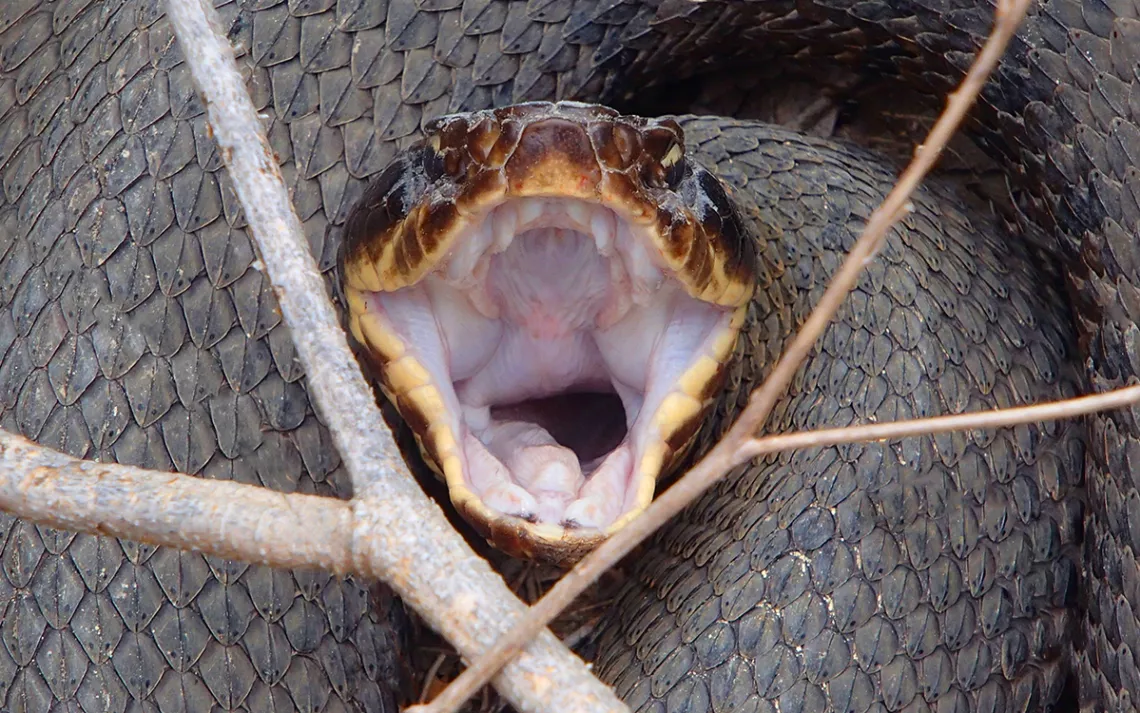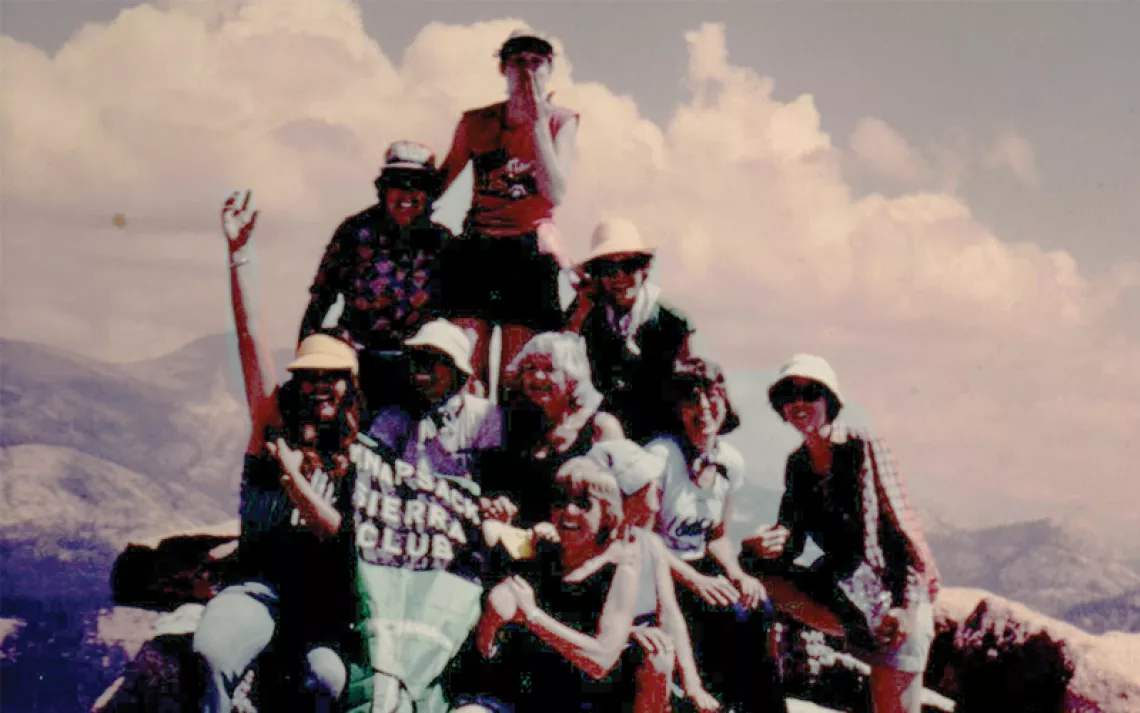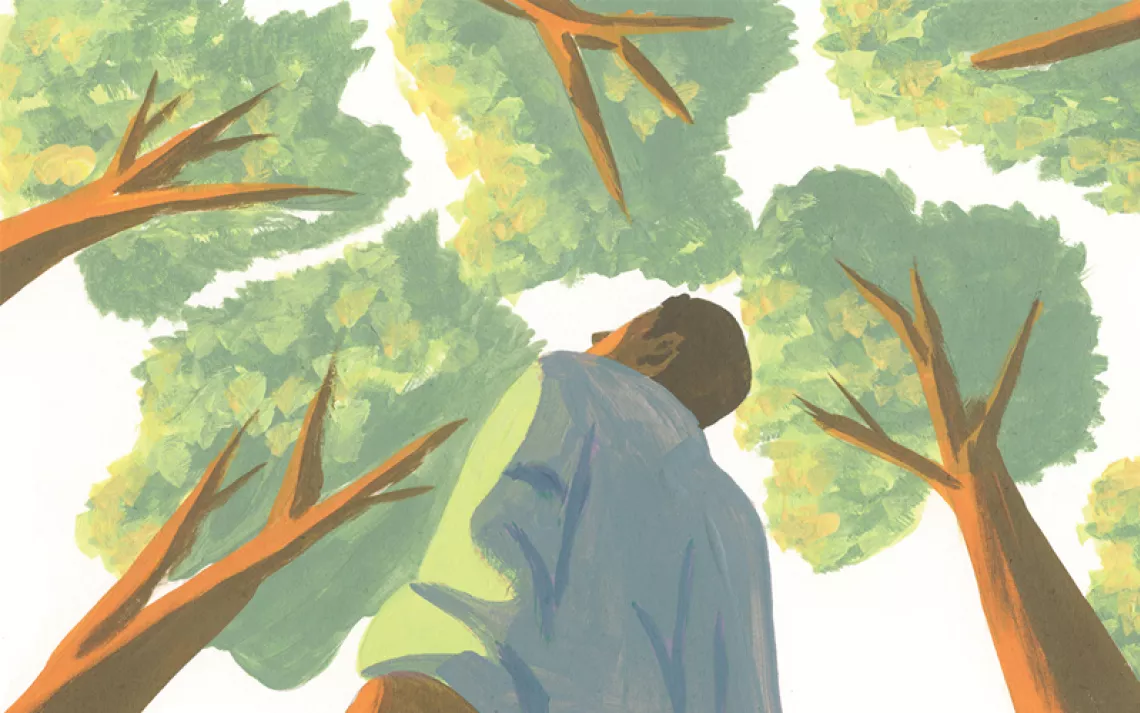ENVIRONMENT EXPLAINED
How to Overcome Your Fear of the Great Outdoors
11 ways to beat the heebie-jeebies this Mental Health Month

Photo by TayRain/iStock
Last year, when my partner was offered a great job in Montana, I immediately agreed to relocate. We’d been living in San Francisco, where I often found myself scheming for ways to get out to the wilderness and spend more time exploring, and “Big Sky Country” had a reputation as an outdoor-lover’s paradise. But once we moved in and set up a trailcam in the backyard, and I saw for myself how many mountain lions, bears, and wolves prowled about, something happened that I didn’t expect—I became reluctant to engage with this coveted new landscape. Instead, I just felt scared and disconnected; my mind was constantly running through worst-case scenarios involving predator attacks and lost cell service.
This Mental Health Awareness Month, I looked into ways of overcoming my newfound fear, and I discovered that I’m not alone. Many outdoor enthusiasts report that fear is a super common reason for avoiding the Great Outdoors. The wilderness, after all, is ripe for spurring the heebie-jeebies—a funny howl, an ursine-looking shadow through a tent, that momentary surge of panic when you get disoriented on a hike.
“To learn to live with our fears so we can enjoy and explore the outdoors, we need to identify and correct unhealthy and unrealistic thought patterns,” says Dr. Holly Schiff, a licensed clinical psychologist based in Greenwich, Connecticut. “The goal is to help yourself modify your behaviors, thoughts, and feelings, and modify them into more realistic, helpful ones.”
I turned to Schiff, as well as several other mental health and medical experts, to learn the best methods for overcoming al fresco fears. And you know what? They’re effective. If anxieties related to critters, heights, heatstroke, bugs, getting lost, or weather have ever kept you indoors, check out these simple steps for courageously getting out there.
1. Identify the roots of your fears. “Figuring out what you actually fear about the outdoors is key,” says Sierra Dator, a licensed clinical social worker in Petaluma, California. Once you have a handle on that, Dator says, you can develop a step-by-step plan to work through it. Say you’re terrified of spiders—is it because of the way their legs move? Or that you think they’ll jump out of a bush and ambush you? Seek out professional guidance, or if you’ve already received cognitive behavioral therapy—a straightforward process of examining the thought cycles that accompany fears and other such triggers—you can dig deep on your own to identify, for example, what really comes up when you hear an unfamiliar noise in the woods or get weak-kneed gazing out from a fabulous vista. “By exploring the maladaptive thoughts you hold and challenging them, the more you’ll see that some of those swirling thoughts are irrational,” says Dr. Manish Mishra, a Nepal-based addiction specialist. Schiff recommends journaling to explore those feelings that come up when your fear response is triggered. “Journaling boosts your mood because you’re putting all your thoughts on paper—a positive outlet.”
2. Get curious about that fear. Los Angeles–based therapist Victoria Smith describes fear, a natural part of life, as “the signal our brain sends us when we perceive any type of danger, whether real or imagined.” She explains: “Our emotions act as messengers, and they carry important information. Reframing fear as a signal or message can help neutralize some of the negative feelings associated with it.” So when an uncomfortable emotion comes up, ask yourself, What does this feeling want me to know? Notice the answer. “If it’s something like, ‘I’ll be in danger and need to stay inside,’” Smith says, you can challenge that fear by asking yourself whether it’s possible you’ll head outdoors and feel, well, okay. “Fear is often a very loud messenger, but it’s just a signal, not a fortune-teller.”
Portland-based psychiatry and family medicine physician Dr. Erik Vanderlip suggests reframing fear as a simple warning light going off on the dashboard of your car. “Just like how you might react if your ‘check engine’ light goes on, it doesn’t mean you have to pull over immediately and call the mechanic. It’s a signal of potential danger—not evidence of actual threat.” Dator adds, “When it comes to anxiety, people want to get rid of the fear entirely, but this isn’t always realistic. For example, while you may never love spiders, you can build a tolerance to being around them, which will reduce the amount of anxiety you feel.” Smith adds that it can be helpful to become aware of the bodily sensations you experience when you’re afraid—say, clammy hands, or a pit that takes over your stomach. “Try to describe these sensations with as many descriptive words as possible. For example, are the sensations dull, hot, or cold? Do they have a color associated with them? The goal of this exercise is not to make the fear go away, but to restructure your relationship to it as a sensation in your body that cannot harm you.”
3. Get to know the gold standard for phobia treatment: exposure therapy. A common aspect of cognitive behavioral therapy, this entails getting exposed to spooky stimuli, in increasing levels of intensity, until the fear becomes extinct. “We call this ‘systematic desensitization’ in people with specific phobias,” says Mishra. “You start slowly, with less threatening and more stable environments, allowing the person to gain the confidence to take on more intense pursuits.” Schiff adds, “Through controlled exposure, you start to associate your fear with more positive outcomes. You get insights into your thought patterns and how they affect your emotions, physical symptoms, and behavior. You work to alter maladaptive thoughts and subsequently change behaviors and feelings.”
How does this actually play out? Say you have a fear of snakes. Before forcing yourself into a multiday desert camping trip, look at picture books with snakes in them. “Do this several times a day, rating your anxiety on a scale from 0 (no anxiety) to 10 (high anxiety),” Dator advises. “Continue with this step until you get down to a 3 or lower. From there, you could watch snake YouTube videos using the same anxiety scale. Next, you could go to a pet store and stand away from the cages. When your anxiety is at a 3 or lower, you might stand right next to the cage.” The next step is to ask an employee to take a snake out of the cage, and finally, you could try to hold it for two seconds. “This process might take several days or weeks to work through, and in the end, you might find you actually do like snakes, or you may never come around to them,” Dator says. “Either way, the goal is to develop tolerance, with less anxiety than you had before.”
4. Develop an understanding—and maybe even some compassion—for whatever terrifies you. It’s okay if you’re not ready to look at pictures of snakes or spiders! Smith says an alternative route is to learn as much as you can about whatever you fear. “Research interesting facts about spiders, so you can find some type of connection and more of an understanding of their purpose on this Earth. Some clients have found it helpful to learn about creatures’ survival tactics, so they can find some compassion toward the creature, as it’s just trying to survive and isn’t targeting them personally.”
5. Arm yourself with hard data about your surroundings. Dr. Christian Glasgow, a clinical psychologist in Ventura, California, who specializes in sports psychology, points out that higher elevation and altitude in and of itself will exacerbate an individual’s experience of anxiety symptoms such as shortness of breath, hypoxia, and hyperventilation. “I’m big on psychoeducation—on giving yourself a road map of what to expect based on your surroundings,” Glasgow says. “A lot of people who’ve never been to the ocean assume a great white is going to immediately attack them, or that a bear’s going to get them in a place like Montana, but if you look at the statistics, you’ll find most such attacks are very, very rare events.” The idea, he notes, is to preemptively gain understanding of how new environments are viscerally and physiologically going to affect you. “In most new circumstances, you should expect to be anxious—and learn to lean on more experienced adventurers,” he says. “Ask them about their experiences—find that voice of reason, that person who can give you a heads-up, and whose enthusiasm is going to remind you why it’s probably worthwhile to push through the discomfort and have the experience.” Otherwise, Glasgow points out, we’re prone to falling into the common trap that is confirmation bias: “When we’re only paying attention to that info that confirms our existing beliefs or anxieties or bias, too often that’s why people shut it down early and quit. They come into an outdoor space fearful, and as soon as that fear feels confirmed, they think it’s gonna get worse, so they stop.”
6. Practice mindfulness in the great outdoors. So often, whatever we fear never actually comes to fruition, yet anxiety still launches us into a thorny patch of what-ifs: What if I get attacked? What if I get heatstroke? What if I fall off that boulder? What if I get lost? The antidote here? Mindfulness, which involves paying attention on purpose, “in the present moment and nonjudgmentally,” says Schiff. “It helps you to focus on the here and now while intentionally increasing your awareness of what is unfolding, moment to moment, in your experience.” Dator adds, “Most often, anxiety lives in either the future or the past; rarely does it live in the present moment. So being mindful—meaning being right here, right now—is much more helpful than rewinding through worst-case scenarios.” Before even heading outdoors, you can practice mindfulness. “Try it right now,” advises Dator. “What do you see, hear, feel, taste, and smell? Getting into your senses will bring you into the present moment and away from anxiety.”
Once you’re actually outdoors, Texas-based psychologist Dr. Lea McMahon says that breathing slowly is the best start to any mindfulness practice. “It’ll trigger your central nervous system to relax, so you’ll be calmer instead of having an extreme reaction to your fears.” Outdoor educator David Miller adds that watching clouds pass by can make for a particularly mindful al fresco exercise. “Watching the sky is a beautiful and relaxing pursuit that has a psychological effect on how you view the outdoors; doing so while you’re exploring can create the same vibe as lying in a gentle meadow.” When the heebie-jeebies strike, Vanderlip suggests wiggling your toes. “Feel the pack on your shoulders. Take a mental inventory of what you’re feeling, physically, starting from toes to head. Also, core into the why of your outdoor experience. What did you go there for? Keeping in mind that you want to check in with nature, experience the world around you, stay fit and active, or bond with others can help you push through any anxieties that crop up along the way. You’ll realize you can continue on because the end will justify the means, and the more you focus on your why, the less time you’ll spend thinking about the anxiety or fear, and the more you’ll come to thank it for doing exactly what it’s supposed to do—keeping you on your toes about potential dangers in your environment.”
7. Focus on outdoor goals. Glasgow reminds us that in any unknown environment, there’s a natural bias toward fear. “Everyone thinks about the potential risks and what can go wrong, not what can go right—because if it bleeds, it leads. We have to train ourselves to think about what can go right, so we can fully enjoy the experience.” This reframing involves telling yourself, This is gonna be difficult, but I’m gonna come out of it having accomplished something. “The small victories—getting to the summit or finishing the famously hard hike—are what keep people coming back,” Glasgow adds. “[Goals] breed resilience and confidence and competency in that natural environment. Once you have that goal in mind, the challenge is what’s going to make the experience great—it’ll keep you fulfilled and engaged when the going gets tough.”
8. Practice radical acceptance. Simply put, this entails acknowledging that there is a lot about a given circumstance we cannot control or change—and doing so helps us better understand what falls within and outside our circle of control. “It’s important to exercise control in healthy ways where we can,” says Schiff. What does controlling those variables we can look like? “Bring the right gear and comfortable clothing, plenty of water and snacks and maps, and become aware of the weather beforehand,” advises Miller. “Being in control of what you possibly can control helps significantly with self-confidence. While you can still encounter harsh weather or dangerous animals, knowing that you have the proper clothing and self-defense tools will help enormously with self-confidence.” In my case, radical acceptance has involved acknowledging that, yes, I might see a bear on a local hike. But it’s helped me to understand that avoiding the woods isn’t the answer. In taking stock of what I can control, I’ve learned to use and started trekking with bear spray. “Every little bit counts and gives you a sense of control over your world,” says Schiff.
9. On that note, develop more outdoor knowledge (because knowledge really is power). Learn what triggers bears, or how to read a compass, and you’ll empower yourself to overcome anxiety about getting lost. “If you take a first-aid class, your fears about injuries and snakebites will be reduced,” Dator says. “If you know exactly how much water you need to drink to avoid dehydration and how you use a small filtration system, you’ll feel capable of caring for yourself.” Fearful of the sun? “Read about the positive things it provides to our lives and the planet,” Smith suggests. “If you’re afraid of it damaging your skin, make sure you’re comfortable and feel in control of the sun protection you’re using.”
10. Become the master of your own thought cycles. Once you get a handle on your thought cycles, Dator says, you can better shift your thought patterns so that they’re more helpful. If your ultimate goal is going on a camping trip but you’re worried about snakes or spiders or bad weather or not having phone service, you can train your brain to lead with the thought, I am excited to go on this camping trip! “That thought will lead you to feel happy, and from there, your action is smiling and you can move through your thought cycle in a more positive direction, which has the ability to decrease anxiety,” Dator explains.
11. Now get out there! Remember that there’s no right or wrong timeline for getting yourself out into the world and that feeling uncomfortable is a natural and expected part of the process. “That means you’re doing something right!” Smith says. “Go slowly and choose one activity to challenge yourself—start with something low stakes and try to implement some level of fun.” McMahon notes that scheduling and accountability can ensure you actually get out there. “If you’re putting off an outdoor activity because of your fear, you need to follow through. It may not be easy initially, but it’s something you have to do to enjoy your life to the fullest.” Glasgow reminds us, “Expect to be anxious, and that sensation won’t feel like such a warning bell. Don’t fight it, but go into your adventure as a learning experience. And focus on the positive outcomes—the fun and the bonding and the achievement—because that’s what outdoor adventure’s all about. Small reframes make a huge difference.”
 The Magazine of The Sierra Club
The Magazine of The Sierra Club



